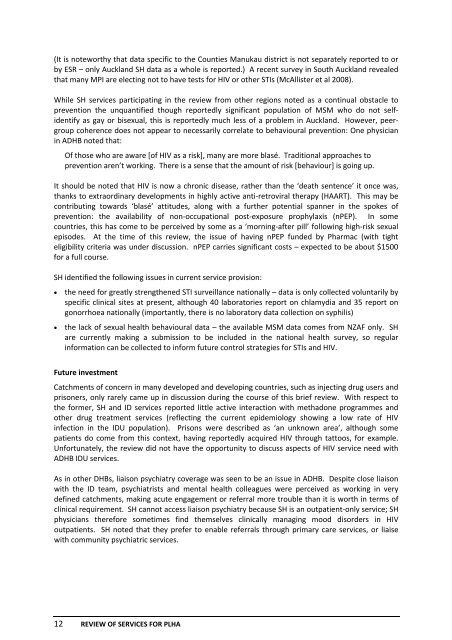Review of services for people living with HIV in New Zealand
Review of services for people living with HIV in New Zealand
Review of services for people living with HIV in New Zealand
- No tags were found...
Create successful ePaper yourself
Turn your PDF publications into a flip-book with our unique Google optimized e-Paper software.
(It is noteworthy that data specific to the Counties Manukau district is not separately reported to orby ESR – only Auckland SH data as a whole is reported.) A recent survey <strong>in</strong> South Auckland revealedthat many MPI are elect<strong>in</strong>g not to have tests <strong>for</strong> <strong>HIV</strong> or other STIs (McAllister et al 2008).While SH <strong>services</strong> participat<strong>in</strong>g <strong>in</strong> the review from other regions noted as a cont<strong>in</strong>ual obstacle toprevention the unquantified though reportedly significant population <strong>of</strong> MSM who do not selfidentifyas gay or bisexual, this is reportedly much less <strong>of</strong> a problem <strong>in</strong> Auckland. However, peergroupcoherence does not appear to necessarily correlate to behavioural prevention: One physician<strong>in</strong> ADHB noted that:Of those who are aware [<strong>of</strong> <strong>HIV</strong> as a risk], many are more blasé. Traditional approaches toprevention aren’t work<strong>in</strong>g. There is a sense that the amount <strong>of</strong> risk [behaviour] is go<strong>in</strong>g up.It should be noted that <strong>HIV</strong> is now a chronic disease, rather than the ‘death sentence’ it once was,thanks to extraord<strong>in</strong>ary developments <strong>in</strong> highly active anti‐retroviral therapy (HAART). This may becontribut<strong>in</strong>g towards ‘blasé’ attitudes, along <strong>with</strong> a further potential spanner <strong>in</strong> the spokes <strong>of</strong>prevention: the availability <strong>of</strong> non‐occupational post‐exposure prophylaxis (nPEP). In somecountries, this has come to be perceived by some as a ‘morn<strong>in</strong>g‐after pill’ follow<strong>in</strong>g high‐risk sexualepisodes. At the time <strong>of</strong> this review, the issue <strong>of</strong> hav<strong>in</strong>g nPEP funded by Pharmac (<strong>with</strong> tighteligibility criteria was under discussion. nPEP carries significant costs – expected to be about $1500<strong>for</strong> a full course.SH identified the follow<strong>in</strong>g issues <strong>in</strong> current service provision:the need <strong>for</strong> greatly strengthened STI surveillance nationally – data is only collected voluntarily byspecific cl<strong>in</strong>ical sites at present, although 40 laboratories report on chlamydia and 35 report ongonorrhoea nationally (importantly, there is no laboratory data collection on syphilis)the lack <strong>of</strong> sexual health behavioural data – the available MSM data comes from NZAF only. SHare currently mak<strong>in</strong>g a submission to be <strong>in</strong>cluded <strong>in</strong> the national health survey, so regular<strong>in</strong><strong>for</strong>mation can be collected to <strong>in</strong><strong>for</strong>m future control strategies <strong>for</strong> STIs and <strong>HIV</strong>.Future <strong>in</strong>vestmentCatchments <strong>of</strong> concern <strong>in</strong> many developed and develop<strong>in</strong>g countries, such as <strong>in</strong>ject<strong>in</strong>g drug users andprisoners, only rarely came up <strong>in</strong> discussion dur<strong>in</strong>g the course <strong>of</strong> this brief review. With respect tothe <strong>for</strong>mer, SH and ID <strong>services</strong> reported little active <strong>in</strong>teraction <strong>with</strong> methadone programmes andother drug treatment <strong>services</strong> (reflect<strong>in</strong>g the current epidemiology show<strong>in</strong>g a low rate <strong>of</strong> <strong>HIV</strong><strong>in</strong>fection <strong>in</strong> the IDU population). Prisons were described as ‘an unknown area’, although somepatients do come from this context, hav<strong>in</strong>g reportedly acquired <strong>HIV</strong> through tattoos, <strong>for</strong> example.Un<strong>for</strong>tunately, the review did not have the opportunity to discuss aspects <strong>of</strong> <strong>HIV</strong> service need <strong>with</strong>ADHB IDU <strong>services</strong>.As <strong>in</strong> other DHBs, liaison psychiatry coverage was seen to be an issue <strong>in</strong> ADHB. Despite close liaison<strong>with</strong> the ID team, psychiatrists and mental health colleagues were perceived as work<strong>in</strong>g <strong>in</strong> verydef<strong>in</strong>ed catchments, mak<strong>in</strong>g acute engagement or referral more trouble than it is worth <strong>in</strong> terms <strong>of</strong>cl<strong>in</strong>ical requirement. SH cannot access liaison psychiatry because SH is an outpatient‐only service; SHphysicians there<strong>for</strong>e sometimes f<strong>in</strong>d themselves cl<strong>in</strong>ically manag<strong>in</strong>g mood disorders <strong>in</strong> <strong>HIV</strong>outpatients. SH noted that they prefer to enable referrals through primary care <strong>services</strong>, or liaise<strong>with</strong> community psychiatric <strong>services</strong>.12 REVIEW OF SERVICES FOR PLHA
















